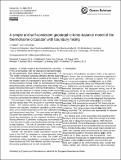A simple and self-consistent geostrophic-force-balance model of the thermohaline circulation with boundary mixing
Author(s)
Callies, Joern; Marotzke, J.
DownloadCallies-2012-A simple and self-co.pdf (7.210Mb)
PUBLISHER_CC
Publisher with Creative Commons License
Creative Commons Attribution
Terms of use
Metadata
Show full item recordAbstract
A simple model of the thermohaline circulation (THC) is formulated, with the objective to represent explicitly the geostrophic force balance of the basinwide THC. The model comprises advective-diffusive density balances in two meridional-vertical planes located at the eastern and the western walls of a hemispheric sector basin. Boundary mixing constrains vertical motion to lateral boundary layers along these walls. Interior, along-boundary, and zonally integrated meridional flows are in thermal-wind balance. Rossby waves and the absence of interior mixing render isopycnals zonally flat except near the western boundary, constraining meridional flow to the western boundary layer. The model is forced by a prescribed meridional surface density profile.
This two-plane model reproduces both steady-state density and steady-state THC structures of a primitive-equation model. The solution shows narrow deep sinking at the eastern high latitudes, distributed upwelling at both boundaries, and a western boundary current with poleward surface and equatorward deep flow. The overturning strength has a 2/3-power-law dependence on vertical diffusivity and a 1/3-power-law dependence on the imposed meridional surface density difference. Convective mixing plays an essential role in the two-plane model, ensuring that deep sinking is located at high latitudes. This role of convective mixing is consistent with that in three-dimensional models and marks a sharp contrast with previous two-dimensional models.
Overall, the two-plane model reproduces crucial features of the THC as simulated in simple-geometry three-dimensional models. At the same time, the model self-consistently makes quantitative a conceptual picture of the three-dimensional THC that hitherto has been expressed either purely qualitatively or not self-consistently.
Date issued
2012-01Department
Joint Program in Chemical Oceanography; Massachusetts Institute of Technology. Department of Earth, Atmospheric, and Planetary Sciences; Woods Hole Oceanographic InstitutionJournal
Ocean Science
Publisher
Copernicus GmbH
Citation
Callies, J., and J. Marotzke. “A Simple and Self-consistent Geostrophic-force-balance Model of the Thermohaline Circulation with Boundary Mixing.” Ocean Science 8.1 (2012): 49–63. Web. 26 Apr. 2012.
Version: Final published version
ISSN
1812-0792
1812-0792